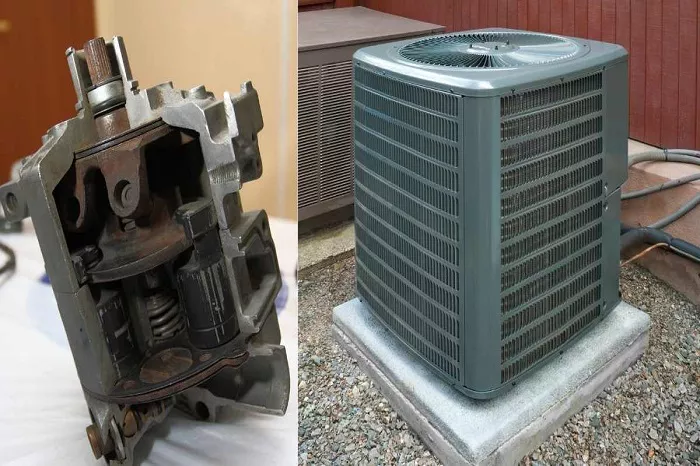In air conditioning (AC) systems, the compressor and condenser are two critical components that work together to provide cooling. While they are often mentioned together, they serve very different functions. Understanding their differences is essential for HVAC professionals, technicians, and even informed homeowners who want to maintain or troubleshoot their systems.
Overview of the AC Refrigeration Cycle
Compressor: Compresses refrigerant gas, increasing its pressure and temperature.
Condenser: Cools the high-pressure refrigerant gas, turning it into a liquid.
Expansion Valve: Reduces refrigerant pressure, allowing it to expand and cool.
Evaporator: Absorbs heat from indoor air, turning the refrigerant back into a gas.
The compressor and condenser are located in the outdoor unit (in split systems), while the evaporator is inside.
What is an AC Compressor?
Function
- Increase refrigerant pressure, raising its temperature.
- Circulate refrigerant through the system.
- Maintain flow between the evaporator and condenser.
Without a functioning compressor, the refrigerant cannot move, and cooling stops.
What is an AC Condenser?
Function
The condenser is responsible for
- Releasing heat from the refrigerant to the outside air.
- Converting high-pressure gas into liquid refrigerant.
- Working with the compressor to maintain system pressure.
Types of Condensers
Air-Cooled Condenser
- Most common in residential ACs.
- Uses a fan to blow air over refrigerant coils.
Water-Cooled Condenser
- Uses water to cool refrigerant (common in industrial systems).
- More efficient but requires a cooling tower.
Evaporative Condenser
- Combines air and water cooling.
- Used in large commercial setups.
How the Condenser Works
- The hot, high-pressure refrigerant gas enters the condenser coils.
- The condenser fan blows outside air over the coils, removing heat.
- The refrigerant condenses into a liquid as it cools.
- The liquid refrigerant flows to the expansion valve.
Common Condenser Problems
- Dirty or clogged coils (reduces heat transfer).
- Fan motor failure (restricts airflow).
- Refrigerant leaks (causes poor cooling).
- Electrical issues (bad contactor or capacitor).
Maintenance Tips
- Clean condenser coils regularly (dirt reduces efficiency).
- Check fan operation (ensure blades are intact).
- Inspect refrigerant lines for leaks.
- Clear debris around the outdoor unit.
Key Differences Between Compressor & Condenser
| Feature | Compressor | Condenser |
|---|---|---|
| Function | Compresses refrigerant gas | Cools refrigerant into liquid |
| Location | Outdoor unit (near condenser) | Outdoor unit |
| Main Components | Motor, pistons/scrolls, valves | Coils, fan, fins |
| Refrigerant State | High-pressure gas | High-pressure liquid |
| Common Issues | Electrical failure, mechanical wear | Dirty coils, fan problems |
| Maintenance Needs | Oil checks, electrical inspection | Coil cleaning, fan checks |
Why Both Components Are Critical
- The compressor ensures refrigerant circulation and pressure buildup.
- The condenser removes heat, allowing the refrigerant to condense.
- If either fails, the entire AC system stops working.
Conclusion
Proper maintenance of both components ensures efficient cooling and longer system life. Understanding their differences helps in troubleshooting and repairs, making you better equipped to handle AC issues.For HVAC professionals, recognizing the signs of failure in each component can prevent costly breakdowns and improve system longevity. Regular maintenance of both the compressor and condenser is essential for efficient, reliable cooling.

